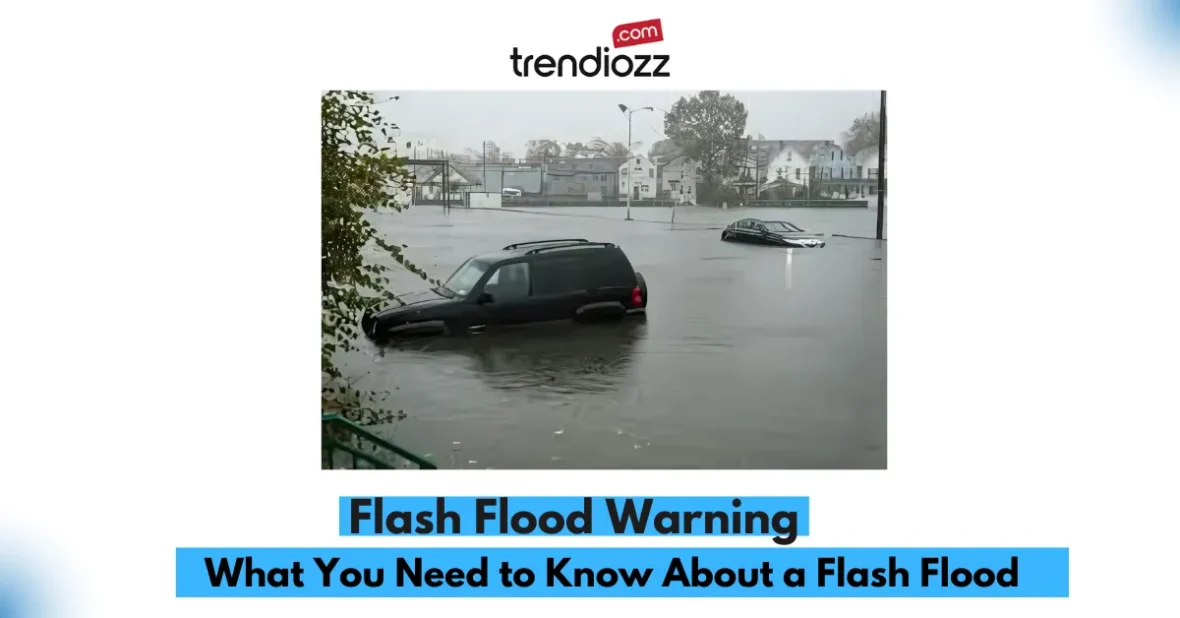A flash flood warning is something we often hear during stormy seasons, but how many of us truly understand the gravity of it? When a flash flood warning is issued, it’s not just about heavy rain—it signals an immediate threat to life and property. With extreme weather becoming more frequent due to climate change, these warnings are becoming more common and critical. Let’s break down exactly what a flash flood warning means, why it’s so dangerous, and how you can stay safe when one is issued.
Important Flash Flood Safety Tips
| Safety Tip | Explanation |
|---|---|
| Move to Higher Ground | Get to an elevated area immediately when a warning is issued. |
| Avoid Flooded Roads | Never attempt to drive through floodwaters, even if they appear shallow. |
| Monitor Weather Reports | Stay informed via weather alerts and news updates. |
| Prepare an Emergency Kit | Keep essential supplies like water, food, and first aid kits ready. |
| Safeguard Important Documents | Store documents in waterproof containers to avoid loss during floods. |
| Elevate Appliances | Raise electrical appliances above expected flood levels to avoid damage. |
| Follow Evacuation Orders | Obey local authorities and evacuate when ordered. |
| Create a Family Plan | Ensure all family members know what to do and where to go during a flood. |
| Stay Indoors During Heavy Rainfall | Avoid going outside during intense storms unless absolutely necessary. |
| Use Social Media for Updates | Follow local weather services and community updates on social media. |
What is a Flash Flood Warning?
A flash flood warning is an alert issued by meteorological agencies, such as the National Weather Service (NWS), when flash flooding is either already occurring or is imminent in your area. Unlike general flood warnings that cover gradual rises in water levels, a flash flood happens rapidly, usually within six hours of heavy rainfall or other events like dam breaks.
These floods are especially dangerous because they come with little to no warning, leaving residents and travelers very little time to prepare or evacuate. Flash flood warnings are often associated with thunderstorms, hurricanes, or the sudden collapse of levees and dams. In mountainous or urban areas, flash floods can develop in minutes and without any visible sign of rain nearby, making them a silent and often deadly threat.
Why Do Flash Floods Happen?
Flash floods can be triggered by several factors, but the most common cause is intense rainfall over a short period. This is particularly common in places with poor drainage systems, steep terrain, or areas where the ground is already saturated. Here’s why flash floods happen:
1. Heavy Rainfall in a Short Timeframe
This is the primary cause of flash floods. When the ground can’t absorb water fast enough, excess water turns into runoff, creating dangerous flooding conditions.
2. Urbanization
Cities with large areas of pavement and concrete can’t absorb water, which leads to excessive surface runoff. This can overwhelm stormwater systems and cause urban flash flooding.
3. Topography
In mountainous areas, rainfall runs downhill quickly, collecting speed and volume. This can turn a trickling stream into a raging river within minutes.
4. Dam or Levee Failures
Sudden failures of man-made structures can cause walls of water to rush downstream, inundating communities in minutes.
5. Snowmelt and Ice Jams
In colder regions, rapid snowmelt or ice breaking apart in rivers can cause water levels to rise quickly, leading to flash flooding.
The Dangers of Ignoring a Flash Flood Warning
Imagine this: It’s a stormy evening, and your phone buzzes with a flash flood warning alert. You think, “It’s just some rain; I’ve seen worse.” This mindset can be deadly. Flash floods are not only fast-moving but also highly unpredictable. When you ignore a warning, you may be putting yourself and your family in harm’s way.
Real-Life Example: The 2016 Ellicott City Flood
In 2016, Ellicott City, Maryland, experienced one of the most devastating flash floods in U.S. history. Within just two hours, over six inches of rain fell, leading to destructive floodwaters rushing through the city. Cars were swept away, businesses were destroyed, and lives were tragically lost. Many had just minutes to seek higher ground, emphasizing the importance of taking a flash flood warning seriously.
What Should You Do When a Flash Flood Warning is Issued?
Now that you understand the dangers, let’s focus on how to stay safe when a flash flood warning is issued.
1. Move to Higher Ground
The most important rule when dealing with flash floods is to get to higher ground immediately. Flash floods can turn roads and valleys into death traps in minutes. Don’t wait—act fast.
2. Avoid Walking or Driving Through Floodwaters
It’s tempting to think your car can handle a few inches of water, but did you know that just six inches of moving water can knock over an adult, and 12 inches can carry away a small car? Never drive through flooded roads; they can be far deeper than they appear.
3. Listen to Local Authorities
Tune in to local weather stations, or check emergency alerts on your phone for updates. Pay attention to evacuation orders and follow directions carefully.
4. Create a Flood Emergency Kit
Having an emergency kit on hand with essentials such as non-perishable food, water, flashlights, and first aid supplies can be lifesaving if you need to evacuate quickly.
5. Plan Your Evacuation Route
Know the safest routes out of your area and ensure that all family members are aware of it. Make sure your evacuation plan includes places to reunite if you get separated.
Flash Flood Warning vs. Watch: What’s the Difference?
Understanding the difference between a flash flood warning and a watch can help you respond appropriately.
- Flash Flood Watch: Conditions are favorable for flash flooding, but it hasn’t occurred yet. This is the time to prepare and stay alert.
- Flash Flood Warning: Flash flooding is happening now or is about to happen. Immediate action is required to protect yourself.
When you hear a flash flood warning, it means that you need to take immediate steps to protect yourself, whereas a watch is more of a “be prepared” situation.
Flash Flood Preparedness: What You Need to Know
Flash floods strike quickly, so it’s essential to be prepared ahead of time, especially if you live in a flood-prone area. Here are key preparedness tips:
1. Monitor Weather Reports Regularly
Use reliable sources like the National Weather Service to keep track of weather patterns, especially during storm seasons. Signing up for weather alerts on your phone can give you a head start when conditions worsen.
2. Safeguard Important Documents
Keep copies of essential documents like insurance policies, medical records, and identification in a waterproof container or digitally backed up. This can be vital in the aftermath of a flood.
3. Have a Family Communication Plan
During emergencies, it’s easy for family members to get separated. Make sure everyone knows where to go and how to contact each other if a flash flood warning is issued.
4. Elevate Electrical Appliances
If you live in a flood-prone area, consider raising electrical appliances such as water heaters and circuit breakers above expected flood levels to prevent serious damage.
The Role of Technology in Flash Flood Warning Systems
With advancements in technology, we’ve seen significant improvements in how flash flood warnings are issued. Satellites, Doppler radar, and real-time river gauges allow meteorologists to monitor weather patterns more accurately than ever before. Today, warnings can be sent directly to your smartphone, giving you valuable time to act.
The Rise of Social Media Alerts
In recent years, social media platforms like Twitter and Facebook have become powerful tools for disseminating flash flood warnings. Community members often share real-time information about road conditions, flood levels, and rescue operations. In some cases, these posts have helped save lives by reaching people who might not otherwise have received a formal warning.
Conclusion
A flash flood warning is a serious alert that should never be taken lightly. As climate change accelerates, extreme weather events like flash floods are becoming more common. Staying informed, being prepared, and acting quickly can mean the difference between life and death. Always prioritize safety, and remember that when it comes to flash floods, there’s no such thing as being too cautious.
Common FAQs About Flash Flood Warnings
Q: How much rain does it take to cause a flash flood?
A: Flash floods can happen with as little as three inches of rain in a short period, especially in urban areas with poor drainage.
Q: What areas are most at risk for flash floods?
A: Flash floods are common in urban areas, mountainous regions, and places near rivers or dams. However, flash flooding can occur almost anywhere with intense rainfall.
Q: How do I know if my area is prone to flash flooding?
A: Your local weather service and government agencies often have flood maps that can help you determine if you live in a flood-prone area.
Q: What should I do if I’m caught in my car during a flash flood?
A: Leave your car and move to higher ground immediately if it’s safe to do so. Do not attempt to drive through flooded roads.
Q: Can flash floods happen without rain?
A: Yes, flash floods can result from dam breaks or even distant storms that send water rushing downstream into your area.










